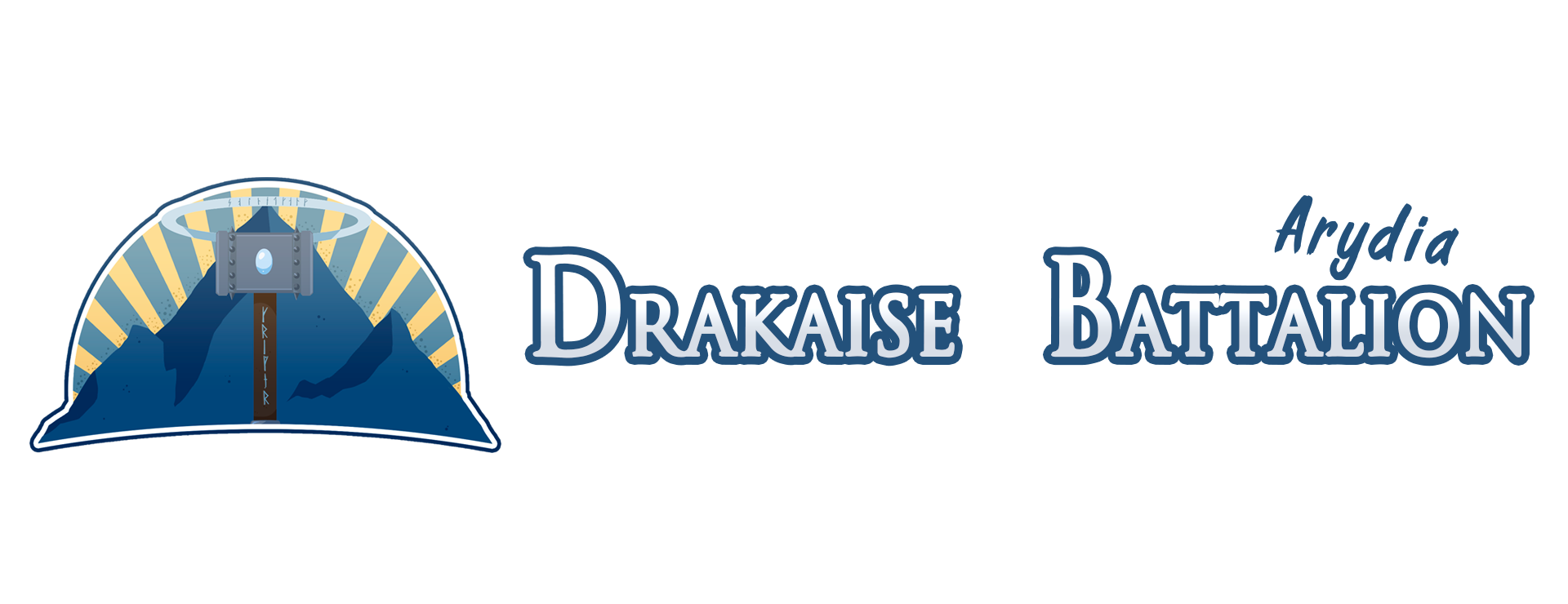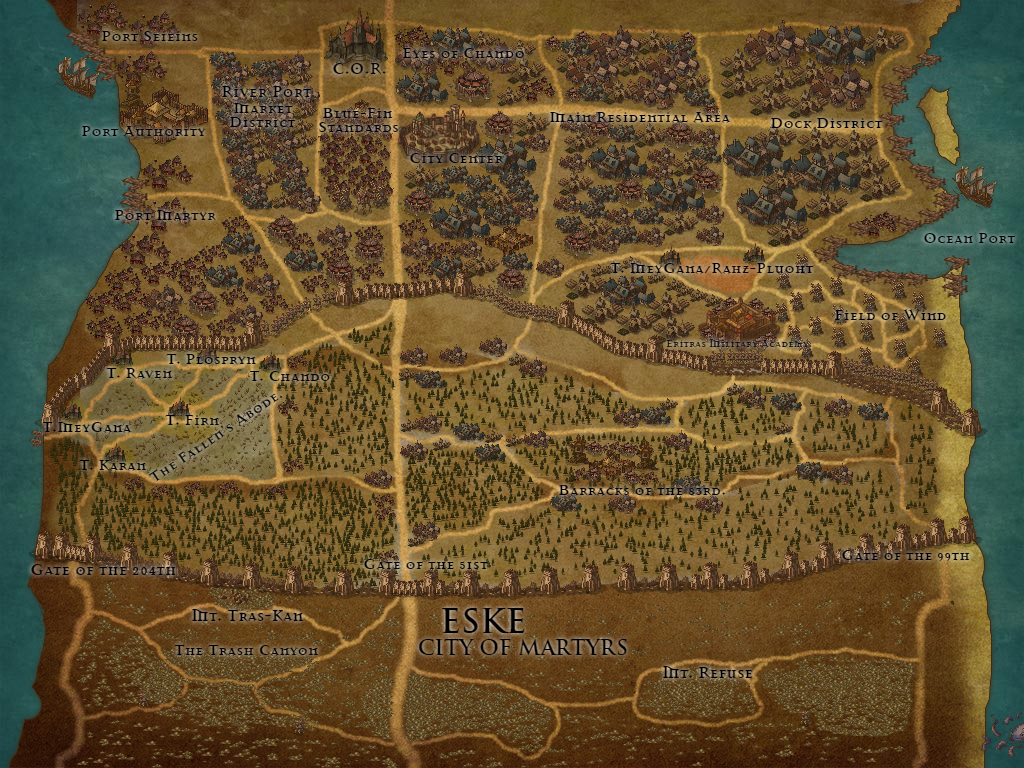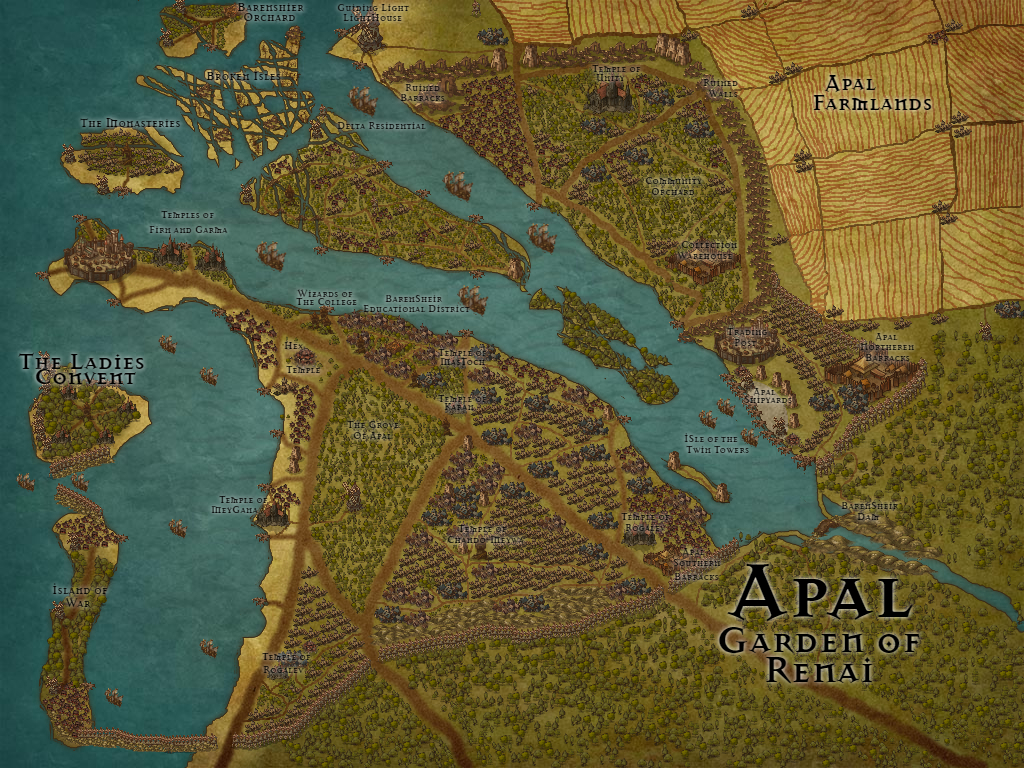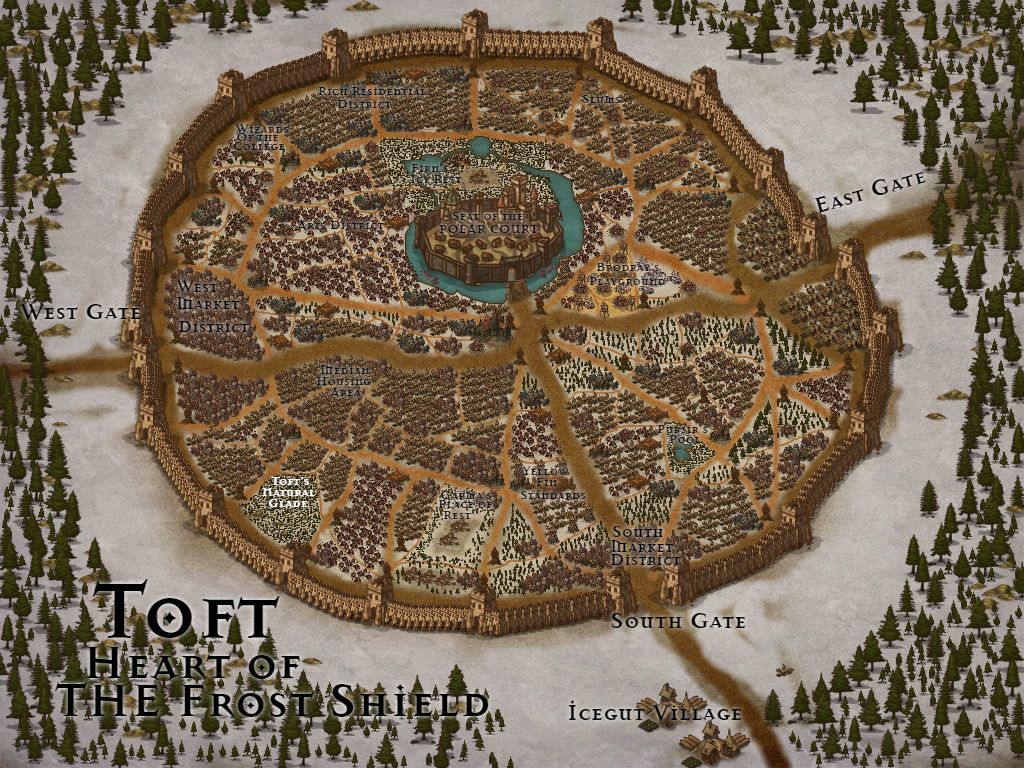Renai
The Devout Monarchy of the north, Ruled by dragon emissaries of the gods and pious to a fault.
The northern wastes, from the Draconic Iceplains and the northern reaches of the Southern Desert, cutting along the backs of the North Feng Mountains to the edges of the Dytikan Coast, this land is dominated by the breath of the The Frost Giant of the North and the will of the Draconic Duo of Brodray and Pursir, both ancient silver dragons that founded the kingdom and have continued to rule over it and it’s people for the last millenia. Their power is immense, and their right to rule; divine.
Some claim that the cold arctic wind that blows from the northern Dytikan Ocean and EverFrost are accentuated by the presence of the two, but the natives remember the frozen wastes being as cold in the times before the landing of the Fourth Fleet. While the dragons hold the throne in their capital of Moldatun, Halfling, their favored subjects rule as a kindly upper class that like nothing more than to party and enjoy the lives they lead in the north.
The economy of Renai is powered by intense material exports along shipping and Train routes, the Draconic Range and The Interior fueling countless mines and the Frost Shield holding as many lumber camps as stars seen from the The Coast of Lights, this has lead to a heavy import-based society that has grown beyond the efforts of local farms. Food is constantly imported from KravMaw and Forkden as their cities grow ever larger and the risks a potential famine could bring become astronomical.
Culturally and socially, the kingdom of Renai is split on a number of fronts. From the division between the Halfling upper class and the other races, the rural and remote populations that battle over importance and needs, and the base religiosity that flows and bends from the various temples claiming the wills of the gods to those that see the gods as something, perhaps darker than they wish to aid and work for the goals of.
Government
The Draconic Duo of Brodray and Pursir are the divinely backed heads of state in Renai, with active social and political presence constantly seen through the country, but as with all great leaders, the day-to-day administration and active running of the nation is delegated. These responsibilities are handled by the halfling-dominated House of Ministers and the Polar Court, each filled with largely electoral positions. The justice system and courts are managed by the Renai Revenge Court, made up of a far more diverse mix of races and are each elected to a 74 year session by the House of Ministers and the previous Revenge Court.The Polar Court
Having been a constant inspiration of romantic literature for the last millennia, the Polar Court has a reputation to uphold. That of halfling nobles spending their days in leisure, bathing in hot springs, enjoying feasts that redefine splendor and elegance; and spending their nights watching plays in crowded halls, avoiding rumors and gossip, while still having clandestine meetings to scheme against their fellow nobles and ministers, as they continue to plot the advancement of their native cities and regions that elected them to conspire within the walls of the polar court.The House of Ministers
The House of Ministers is the other side of the Polar Court, with none of the splendor and gossip, the House is where most real business occurs. From keeping laborers paid, moving product, making sure the vast imports of food arrive on time and under budget, and maintaining peace within their cities. Every aspect of governance has a ministry headed by a Head Minister and a Deputy Minister, each city has its own version of these. Above all of these, managing the House of Ministries is the Prime Minister, who is arguably the most powerful elected official in Renai.Renai Revenge Court
Famous across the lands for decisions on cases both mundane and painful to remember, the Renai Revenge Court is the highest law organization in Ithungsida. Forged by Pursir and Brodray, the court fields cases brought from the entire continent and is recognized as one of the highest courts in all the lands. To enforce their will and retrieve/protect people they have need of, they maintain the Renai Revenge Squads that operate outside of the native laws of the land to achieve results. However, it is rare that the Court tallies small crime. Instead they focus on those cases brought to their attention via the various organizations and kingdoms of the land, and lightly seek out injustices found on their lands. From the Eighth Session's Ban on Atomic Weapons and the Fourteenth Session's Fine against the Entire Lichdom for the Genocide of Orcs. Not to mention the Sixth Session's Abolishment of Renai's laws against Percussion Performances. They oversee any decisions they seen as worthy and their proclamations are final.Foreign relations
Renai strives to be a peaceful nation that reacts to slights against it. It does not declare war, but keeps a large navy in case the shipping routes are threatened. As Renai is overly dependent on food imports from KravMaw and Forkden to feed it’s ever-growing population. As a few examples of current strained relations;- The Elven Collective of Uuku dislikes Renai’s treatment of the Frost Shield in regards to logging efforts. Many demands clarify that logging operations be extremely limited in Southern Renai as the environment is not used to the constant erosion by mortals.
- While many in Renai dislike those that live in Araetule due to the present and growing disregard for the thoughts, beliefs and values of the majority of the Gods.
Military
Renai has never been a large military power, relying instead on the might of their draconic rulers to fend off foes and small town guards to protect their cities, but since The Orcish Incursion there has been a large push for funding in the various academies spread across the nation. With that, the Caelfoc Union have grown in number and support and each city has grown to support a small garrison outside of their town guards. Renai is, however, a strong naval power that holds sway over the north. It is said to rival Forkden’s naval powers with strong armor said to help fend off ice-ridden waters, but would help just as well against cannon-fire and other forms of assault.Geography
Location and borders
The lands of Renai stretch from the northern edges of the Dytikan Coast, along the The Coast of Lights to Moldatun and down the Draconic Plains past Eske and reaching fingertips down into the Southern Desert; between Eske and Apal, the meeting of the Feng Mountains and the Frost Shield demarcate that border.Climate
The The Interior and much of the The Coast of Lights and Draconic Range are in the furthest northern reaches of Arydia, with intense low temperatures. A direct consequence of this is the days stretching till midnight in the middle of summers and the nights eating the day during the depths of winter. Even the summers often have snow on the ground till mid-summer or later, cooled as the region is by the breath of the The Frost Giant of the North. In terms of rainfall, the majority falls as snow and melts in those few months of warm.Economy
Renai has a vibrant economy spread over several major facets, including, but not limited to; Agriculture, Animal Handling, Resource Extraction, Transportation and Entertainment.Agriculture
While the majority of agriculture within Renai is concentrated in the temperate region that Apal dominates, the rest of the country has little recourse for growing most crops due to the short growing season and cool weather. To rectify this, most farmers in Renai find themselves growing a variety of rice known as “Cold Rice” that grows as the snow melts around it, however this isn’t enough to feed the nation and the majority of food is imported from KravMaw and Forkden.Animal Handling
Despite the limited agricultural capability of their lands, or perhaps because of it, the people and natives of Renai have turned to Fishing and Herding, taking ships into ice-filled waters in search of Tuna, and leading large herds of caribou, snow sheep and diregoat through the Frost Shield. These herders supply the lifeblood streams of sustenance for all but the largest towns in Renai, providing constant streams of food where the imported grains might not reach or might not be enough.Resource Extraction
Renai boasts the greatest mineral deposits outside of the depths of SosIwan Mines, with mining towns spread throughout the Draconic Range and The Interior exporting vast quantities of Irong, Gold, Lead, Oil and gems via railways and caravans. Spread throughout the Frost Shield are mines of a different sort, logging camps that provide the fuel for the mines. The Frost Shield holds some of the most comprehensive and well-kept foresting companies with Elven advisors constantly giving input to keep things sustainable.Transport
To support the endless caravans bearing food across the lands of Renai, the government has long kept an eye on the most advanced travel technologies, taking advantage of early Trains technology and the newer Modern Trains and Airships to keep resources moving, as well as maintaining long reaches of highway that are well-tended and built to survive the horrid temperatures known to the region. The Caelfoc Union are an important part of the government, that consists of teams of workers, engineers and wizards that constantly work to maintain the roads, shipping lands and railways that are the arteries of the country.Entertainment
The dark nights of the winters beg release and time to forget. The bards and other so inclined groups within Renai took up the challenge, forming large theater groups, bands of traveling bards, writing serial stories and pioneering literature in ways the rest of Ithungsida can barely imagine. To be an entertainer in Renai, is to be a bringer of light to the darkness; bringing life to the cold huddled masses within the walls of the many cities.Health
To live in Renai is to be cold, know the frost on your windows, and to never die of simple ailments. For those with magical aptitude in Renai are often bribed into the clergy and trained in the healing arts, and those that aren’t are taught to clean and wash away any illnesses demons of The Knotted Snake might foul the air with. With these, the medical care in Renai is impeccable and available to the majority of the population, charity and religious centers often maintaining hospitals at the same time. This culture of cleanliness and hygiene within Renai is of such strength that even the more rural groups make their way into the cities for check-ups and the purchase of soap. Regular bathing is encouraged and the possession of an overly strong body odor is an easy way to get disinvited from social events as it is considered rude, unclean and unhealthy. Considering that most social events are held indoors, being trapped with the smells of each other isn’t known to be the most pleasant. Bathhouses are common across the nation, with many housing complexes within cities boasting their own bathhouses of various qualities, for the middle class a sauna is a necessity. The vast majority of the population believe that frequent bathing and handwashing fend the spirits and demons controlled by the Knotted Snake and Darchada that cause disease far from their homes. Despite all this commitment to hygiene, malnutrition isn’t something magic and good hygiene fixes easily or permanently. Among the middle-lower class, the lack of fresh vegetables contributes to annual outbreaks of Rickets and Scurvy. However, it is noted that in the isolated villages and hunting camps with no halfing population or influence, it is noted that the population very rarely suffers from these common nutritional deficiencies.Education
In the wide majority, Education is prided by Renans as a facet of life rather than some sort of luxury. Any halfling child that doesn’t attend school is shunned, and other races who abstain lose out on many opportunities they could have had. The Renai Education system is ran by massive city-wide schoolhouses known as “Standards”, and is provided through taxes to all children of a teaching age. Many private Schoolhouses teach the richer children that’s parents dislike the concept of trusting their children to the government. Some humans and kobolds view the Renai education system with suspicion, viewing it as a scheme led by distant halfling nobles to erase the traditions of the native Northern Ithungsidans and indoctrinate their children. Teachers are licensed by the local school board after the completion of extended tutoring on the topics they will be teaching, and despite the less stringent social requirements for non-halflings to attend school, Renai has the highest literacy rate outside of Araetule.Culture
Architecture
Most homes in the major cities of Renai are build out of quarried stone, as timber is a difficult and expensive commodity to obtain, since most of the major cities are located in treeless areas. Most homes are built with two main rooms, a smaller kitchen room with a stovefire and a hypocaust, which funnels hot air underneath the floor of the main room, keeping the house warm and cozy. The main room also contains a second hearth called the Sacred Hearth, which serves to heat the house even further and is used in household religious ceremonies to honor Garma. The exception to the quarried stone homes and buildings is in Toft, where most homes and buildings are built out of lumber. Toft is known for specatular examples of timber architecture, with spectacularly carved and painted decorations. For the native tribes of Renai, their type of homes depended on the type of climate they lived in and what resources were available. For the tribes who lived in the barren polar tundra, life was largely nomadic, with big tent villages during the summer, to expertly crafted igloos and snowhouses made by roaming bands during the winter. For the tribes who live in the Frost Shield, or when large stands of trees were readily available, permanent dwellings were often constructed with logs and cut sod piled around. The Frost Shield people and folks living in the forests around Toft would live in these permanent dwellings largely in the winter, in villages, and break up into roaming hunting camps during the summer.Religion
Worship is deeply integrated into the society and cultural lifeblood of Renai, from morning ceremonies affirming the many bonds of Firn, the Chilled Halfling, to the nightly prayers dedicating meals to Garma, the Halfing of the Hearth. While the rest of the pantheon is worshipped as well, Garma and Firn tend to hold the highest positions in the public eye, with Chando Meywa, the Distant Arctele falling into second place as she represents the various original traditions and understandings of the world that echo through time from before the landing of the Fourth Fleet. The rest of the Pantheon is openly welcomed in the land of Renai, all noting that the gods have their place and deserve the respect for their domains.Music
Human Percussion Ceremony
An orchestra made up entirely of drums, percussion instruments, flutes and chanting, an holdover from an ancient human culture that existed in Northern Ithungsida prior to the landing of the Fourth Fleet of Iwa and the Ascension of Vhaskus. Each instrument has a different symbolic meaning, and the intertwining of melody and harmony work together to tell a story. Songs can be played by a minimum of one person with a drum, to an entire orchestra of sixty people involving twenty different types of drums. Knowing all the different allegorical meanings of each instrument and motif takes years of study. There is an entire school of bards dedicated to the preservation of the songs and stories that make up Human Percussion Ceremony. In the past the halfling upper-class attempted to suppress the percussion ceremony, seeing it as an un-Renai and an uncivilized practice among the humans. The police persecuted bards who would play and maintain it in secret, and this continued for a several generations until the Renai Revenge Court ruled against the persecution and demanded the House of Ministers to stop during the Sixth Renai Revenge Court Session in 511. In current day it is celebrated as an integral part of Renai culture, with a number of orchestras both touring Renai and other major cities.Fashion
Most clothing worn in the cities and the halfling upperclass consists of brightly dyed and embroidered wool tunics and trousers. Halfing clothing usually usually consists of tunics that reach below the hips and leggings The native populations however prefer to wear animal skins sewn into parkas and other clothing made from the caribou herds they take care of and the animals they hunt, although halfling influence has spread the use wool clothing even into the tribal populations.Society and Lifestyle
The Nobility and Upper Class
The lives of the Halfling nobility and upperclasses consist of constant, extravagant parties that seem to never stop. Halflings are known to enjoy their creature comforts and the nobility of Renai exemplify and prove this point at almost every opportunity, although full on hedonism and debauchery is frowned upon and seen as crass by the nobility and commonfolk, finding such behavior to be a stain in the reputation of the Hearth Halflings.City Life
Iwa cultural influence from the halflings has trickled down to the city populations and largely reflects in the "Hearth Halflings", who's culture best reflects their Iwan origins and the stereotypical outlook of halfings--simple joys, good food and a warm fire. City life is often shielded from the hardships of rural life, but it's hard to forget the fragile house of cards that Renai urban society is built on top of.Rural Villages and Towns
Towns and villages are often ruled by the other subrace of halflings, the Icegut halflings, who's frigid natures allows them more able to adapt and survive the freezing the freezing temperatures, who serve a critical role in Renai society as a safety net against famine should the unthinkable happen and the trade routes are disrupted. Although their association with ice often makes people assume that they are a cold, distant people, the opposite is true: Iceguts are defined by their generosity and sense of community, for they are happy to share their hearthfires, their meat and are known to show up with herds of caribou to towns stricken with poverty and starvation.Northern Ithungsidan Tribes
The population that doesn't live in major cities and towns often live a nomadic lifetyle steeped in the Old Way, sustaining themselves on hunting and gathering and trading furs, dried meat and fish for needed goods. During the brief summer, these tribes often come together to form large villages that usually stay in one place for the entire summer--unless visited by halfling officials and police--after which they quickly break camp leave to evade tax collectors. During the winter the villages break up into small roaming hunting bands. While most of the original tribes are consist of humans and houndfolk, a number of Icegut halflings live in the frozen tundra in small tribes and hunting parties, and have completely integrated themselves with the native culture and customs, hunting and sharing stories like brothers and old friends.Cuisine
Due to a climate ill-suited for agriculture and a short to non-existent growing season for foraging, the Renan diet mostly consists of protein and animal fat sources, either from hunting, fishing or herding. Grain and potatoes do make up a large portion of the diet in major cities and mining towns as they have more ready access to imported foodstuffs. In addition, fuel to create cooking fires can be rare, especially on the Coast or the interior, where no trees are to be found. In these cases, food is usually cured, fermented, dried or smoked rather than cooked. While meat and fish are often cooked or preserved, raw meat and fish is commonly consumed all over Renai in all social classes, due to its ready availability. The art of thin slices of delicate raw char or salmon was introduced to the Iwan halflings who first came to settle and found Renai, who adopted the practice into their diets. In the city, a common meal is a slice of dense, rye bread, smeared with soft goat cheese and topped with liberal slices of cured salmon, or a bowl of parboiled rice seasoned with salt, sweet vinegar and wine, topped with slices of fresh raw fish. Berries are prized for their taste and nutritional value. They are gathered whenever possible, and the locations of stands can be a jealously guarded secret by hunters or villages. Most commonly found in the Frost Shield, the forests around Toft, consumed berries include arctic raspberries, blueberries, ligonberries, cloudberries, salmonberries, crowberries, and cranberries. In addition, herbs and vegetables are gathered when possible when the weather permits them to grow, and seaherbs and seaweeds are commonly gathered in the coastal regions. In the major cities, large towns and to a lesser extent the larger mining villages, Iwa influence in cuisine is more prevalent, due to the importation of food and large greenhouses to grow cold-tolerant tubers and vegetables.Dumplings
Trade and technological exchanges with Araetule have imported and fostered a love for dumplings among the lower classes for being a practical way of preserving meat all year around thanks to the constantly freezing temperatures. Pelmeni dumplings are popular among the tribes and rural villages for this reason. Usually, during the end of a warmer than average and fruitful summer, a large butchering is done in order to cull the herds to make it easier to feed livestock during the winter. Precious grain and flour is saved for this moment so that large amounts of pelmeni can be produced and frozen, to be eaten all winter long. Preparing the dumplings becomes a simple matter of taking out the amount one wishes to eat and boiling them in water, making them popular among hunters for their portability and ease of preparation in areas where fuel for cooking was easy to find.Demographics
Spoken Languages
Halfling(Official), Common(Official), Draconic, Sylvan.Maps
-
Eske - City of Martyrs
Eske, the City of Martyrs and Oracles. -
Moldatun - Capital of Renai
This is a map of Moldatun, the Capital of Renai! -
Apal - Garden of Renai
Apal is the southernmost city of Devout Monarchy of Renai . With massive fields, it is a burgeoning port city with a large population.
Founding Date
53
Type
Geopolitical, Theocracy
Capital
Alternative Names
Renai
Demonym
Renans
Leader
Head of State
Head of Government
Government System
Monarchy, Theocratic
Power Structure
Unitary state
Economic System
Mixed economy
Subsidiary Organizations
Divines
Location
Related Professions
Controlled Territories
Notable Members
Related Ethnicities







Comments